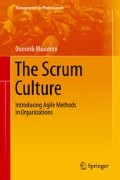Abstract
Scrum is a very simple framework, consisting of just a few meetings, artifacts, roles, and some rules that bind them together. The Scrum Guide is the official definition of Scrum (cf. Schwaber and Sutherland 2013) and contains only 16 pages. This section gives a brief overview and stresses the most important aspects. For a more in-depth view into Scrum, other professional literature is recommended (e.g. Verheyen 2013). One important thing to know is that Scrum views itself merely as a framework, existing in the context of an organizational environment, and being filled with meaning by other methods that complement it (for some examples, see Fig. 23.1). No project—or product development endeavor—will be successful by using only Scrum—complimentary practices are always needed.
Access this chapter
Tax calculation will be finalised at checkout
Purchases are for personal use only
Notes
- 1.
Product absorption is the ability and will of a customer to install and use a new product version. This means the customer has to recognize a benefit for himself and the product installation has to work smoothly with low implementation costs.
- 2.
Scrum is a product development framework. Therefore, the term “process” is not a perfect match. For simplicity, this term is used and includes roles, artifacts and events, as described in the Scrum Guide.
- 3.
This list was created by some of my training participants and includes both traits and skills.
- 4.
cf. Peter and Hull (2011): In a hierarchy every employee tends to rise to his level of incompetence. In other words: If one is good at his job, he will be promoted to the next higher position. Eventually, the skilled worker becomes a manager. If he is no longer suitable for his position and does a bad job, he will no longer get promoted, but instead remains at his post.
- 5.
Imagine for a moment the consultant would reveal that in the past the decisions of the product managers were driven by individual annual bonuses rather than by the company’s goals. This would be most unpleasant for the management team, since they built these bonus schemes into the contracts, did they not?
- 6.
There are teams that for example rotate the Scrum Master role between team members or who appoint a different Product Owner every release. This is usually a huge mistake. Only very experienced and already successful teams can use such approaches in certain situations to increase motivation or solve a specific problem.
- 7.
Velocity is a term representing the sum of all estimates of all Product Backlog items that were completed in one Sprint. Across multiple Sprints the average is calculated and used to forecast the future speed of the team.
References
DeMarco, T., & Lister, T. (2003). Waltzing with bears: Managing risk on software projects. Dorset House: Paperback edition.
DeMarco, T., & Lister, T. (2013). Peopleware: Productive projects and teams (3rd ed.). Reading, MA: Addison-Wesley Professional.
Derby, E., & Larsen, D. (2006). Agile retrospectives: Making good teams great. Raleigh: Pragmatic Bookshelf.
Peter, L. J., & Hull, R. (2011). The peter principle: Why things always go wrong (Reprint editionth ed.). HarperBusiness.
Verheyen, G. (2013). Scrum – A pocket guide. A smart travel companion. Zaltbommel: Van Haren.
Schwaber, K. & Sutherland, J. (July 2013). The scrum guide. Scrum.org. 25.09.2013. https://www.scrum.org/Portals/0/Documents/Scrum%20Guides/2013/Scrum-Guide.pdf#zoom=100
Author information
Authors and Affiliations
Rights and permissions
Copyright information
© 2015 Springer International Publishing Switzerland
About this chapter
Cite this chapter
Maximini, D. (2015). Appendix 3: A Brief Scrum Overview. In: The Scrum Culture. Management for Professionals. Springer, Cham. https://doi.org/10.1007/978-3-319-11827-7_23
Download citation
DOI: https://doi.org/10.1007/978-3-319-11827-7_23
Published:
Publisher Name: Springer, Cham
Print ISBN: 978-3-319-11826-0
Online ISBN: 978-3-319-11827-7
eBook Packages: Business and EconomicsBusiness and Management (R0)

